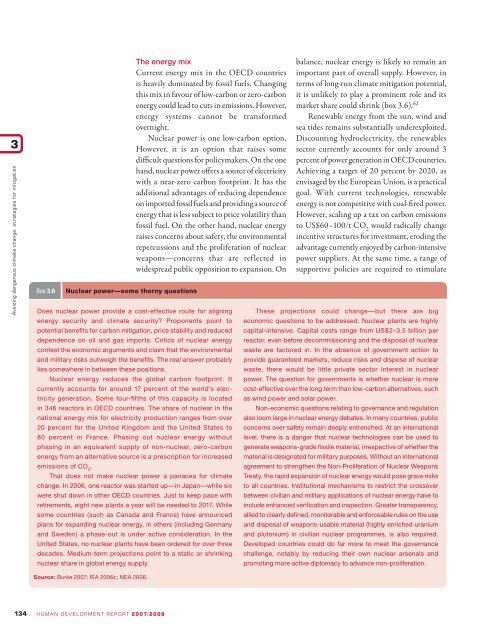The 21st Century climate challenge
The 21st Century climate challenge
The 21st Century climate challenge
You also want an ePaper? Increase the reach of your titles
YUMPU automatically turns print PDFs into web optimized ePapers that Google loves.
3Avoiding dangerous <strong>climate</strong> change: strategies for mitigationBox 3.6Nuclear power—some thorny questions<strong>The</strong> energy mixCurrent energy mix in the OECD countriesis heavily dominated by fossil fuels. Changingthis mix in favour of low-carbon or zero-carbonenergy could lead to cuts in emissions. However,energy systems cannot be transformedovernight.Nuclear power is one low-carbon option.However, it is an option that raises somedifficult questions for policymakers. On the onehand, nuclear power offers a source of electricitywith a near-zero carbon footprint. It has theadditional advantages of reducing dependenceon imported fossil fuels and providing a source ofenergy that is less subject to price volatility thanfossil fuel. On the other hand, nuclear energyraises concerns about safety, the environmentalrepercussions and the proliferation of nuclearweapons—concerns that are reflected inwidespread public opposition to expansion. OnDoes nuclear power provide a cost-effective route for aligningenergy security and <strong>climate</strong> security? Proponents point topotential benefits for carbon mitigation, price stability and reduceddependence on oil and gas imports. Critics of nuclear energycontest the economic arguments and claim that the environmentaland military risks outweigh the benefits. <strong>The</strong> real answer probablylies somewhere in between these positions.Nuclear energy reduces the global carbon footprint. Itcurrently accounts for around 17 percent of the world’s electricitygeneration. Some four-fi fths of this capacity is locatedin 346 reactors in OECD countries. <strong>The</strong> share of nuclear in thenational energy mix for electricity production ranges from over20 percent for the United Kingdom and the United States to80 percent in France. Phasing out nuclear energy withoutphasing in an equivalent supply of non-nuclear, zero-carbonenergy from an alternative source is a prescription for increasedemissions of CO 2.That does not make nuclear power a panacea for <strong>climate</strong>change. In 2006, one reactor was started up—in Japan—while sixwere shut down in other OECD countries. Just to keep pace withretirements, eight new plants a year will be needed to 2017. Whilesome countries (such as Canada and France) have announcedplans for expanding nuclear energy, in others (including Germanyand Sweden) a phase-out is under active consideration. In theUnited States, no nuclear plants have been ordered for over threedecades. Medium-term projections point to a static or shrinkingnuclear share in global energy supply.balance, nuclear energy is likely to remain animportant part of overall supply. However, interms of long-run <strong>climate</strong> mitigation potential,it is unlikely to play a prominent role and itsmarket share could shrink (box 3.6). 62Renewable energy from the sun, wind andsea tides remains substantially underexploited.Discounting hydroelectricity, the renewablessector currently accounts for only around 3percent of power generation in OECD countries.Achieving a target of 20 percent by 2020, asenvisaged by the European Union, is a practicalgoal. With current technologies, renewableenergy is not competitive with coal-fired power.However, scaling up a tax on carbon emissionsto US$60–100/t CO 2would radically changeincentive structures for investment, eroding theadvantage currently enjoyed by carbon-intensivepower suppliers. At the same time, a range ofsupportive policies are required to stimulate<strong>The</strong>se projections could change—but there are bigeconomic questions to be addressed. Nuclear plants are highlycapital-intensive. Capital costs range from US$2–3.5 billion perreactor, even before decommissioning and the disposal of nuclearwaste are factored in. In the absence of government action toprovide guaranteed markets, reduce risks and dispose of nuclearwaste, there would be little private sector interest in nuclearpower. <strong>The</strong> question for governments is whether nuclear is morecost-effective over the long term than low-carbon alternatives, suchas wind power and solar power.Non-economic questions relating to governance and regulationalso loom large in nuclear energy debates. In many countries, publicconcerns over safety remain deeply entrenched. At an internationallevel, there is a danger that nuclear technologies can be used togenerate weapons-grade fissile material, irrespective of whether thematerial is designated for military purposes. Without an internationalagreement to strengthen the Non-Proliferation of Nuclear WeaponsTreaty, the rapid expansion of nuclear energy would pose grave risksto all countries. Institutional mechanisms to restrict the crossoverbetween civilian and military applications of nuclear energy have toinclude enhanced verification and inspection. Greater transparency,allied to clearly defined, monitorable and enforceable rules on the useand disposal of weapons-usable material (highly enriched uraniumand plutonium) in civilian nuclear programmes, is also required.Developed countries could do far more to meet the governance<strong>challenge</strong>, notably by reducing their own nuclear arsenals andpromoting more active diplomacy to advance non-proliferation.Source: Burke 2007; IEA 2006c; NEA 2006.134 HUMAN DEVELOPMENT REPORT 2007/2008




